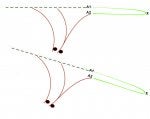silver creek
Well-known member
You can tell when the rod tipped below the SLP to cause the tailing loop be paying attention to when the tail occurs. That will tell you when in the casting stroke, you shocked the rod.Quick update. I was casting my 4 wt last night, and there is much improvement. Something clicked when I watched the Maxine McCormick video. She has a tiny casting stroke and obviously isn’t relying on muscle. Keeping everything in front of my face made me simplify the stroke and minimize movements. I was on the casting pond last night and hitting all the targets from 20 ft to 50 ft without too many tailing loops. I still get tailing loops, just not as many. The annoying thing is that when I do a tailing loop I’m inclined to do a few in a row. It’s never a one-off. Regardless, the TLs are down and the accuracy is up.
I discuss the timing of a tailing loop in the tread below:
Late Tailing Loops
Hi, I'm wondering if you can diagnose where a casting error occurs based on when the tailing loop happens. If a tailing loop occurs late in the forward cast (i.e. when the fly kicks upwards and catches the bottom leg of the loop at the very end of the cast just before landing on the water) and...
www.theflyfishingforum.com
If the tailing loop occurs at the end, when the leader is unfurling; you shocked the rod early in the casting motion.
When the tail occurs in the middle of the cast, you shocked the rod and the rod tip dipped below the SLP in the middle of your casing stroke.
If the loop tail at the beginning of cast soon after loop formation, you shocked the rod late, just before the rod stop at the end of your casting stroke.
So pay attention to when the fly leg fly the loop crosses the rod leg of the loop.


